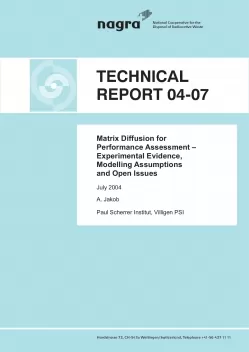
Technical Report NTB 04-07
Matrix Diffusion for Performance Assessment – Experimental Evidence, Modelling Assumptions and Open Issues
In this report a comprehensive overview on the matrix diffusion of solutes in fractured crystalline rocks is presented.
Some examples from observations in crystalline bedrock are used to illustrate that matrix diffusion indeed acts on various length scales. Fickian diffusion is discussed in detail followed by some considerations on rock porosity. Due to the fact that the dual-porosity medium model is a very common and versatile method for describing solute transport in fractured porous media, the transport equations and the fundamental assumptions, approximations and simplifications are discussed in detail. There is a variety of geometrical aspects, processes and events which could influence matrix diffusion. The most important of these, such as, e.g., the effect of the flow-wetted fracture surface, channelling and the limited extent of the porous rock for matrix diffusion etc., are addressed. In a further section open issues and unresolved problems related to matrix diffusion are mentioned. Since matrix diffusion is one of the key retarding processes in geosphere transport of dissolved radionuclide species, matrix diffusion was consequently taken into account in past performance assessments of radioactive waste repositories in crystalline host rocks. Some issues regarding matrix diffusion are site-specific while others are independent of the specific situation of a planned repository for radioactive wastes. Eight different performance assessments from Finland, Sweden and Switzerland were considered with the aim of finding out how matrix diffusion was addressed, and whether a consistent picture emerges regarding the varying methodology of the different radioactive waste organisations. In the final section of the report some conclusions are drawn and an outlook is given. An extensive bibliography provides the reader with the key papers and reports related to matrix diffusion.
